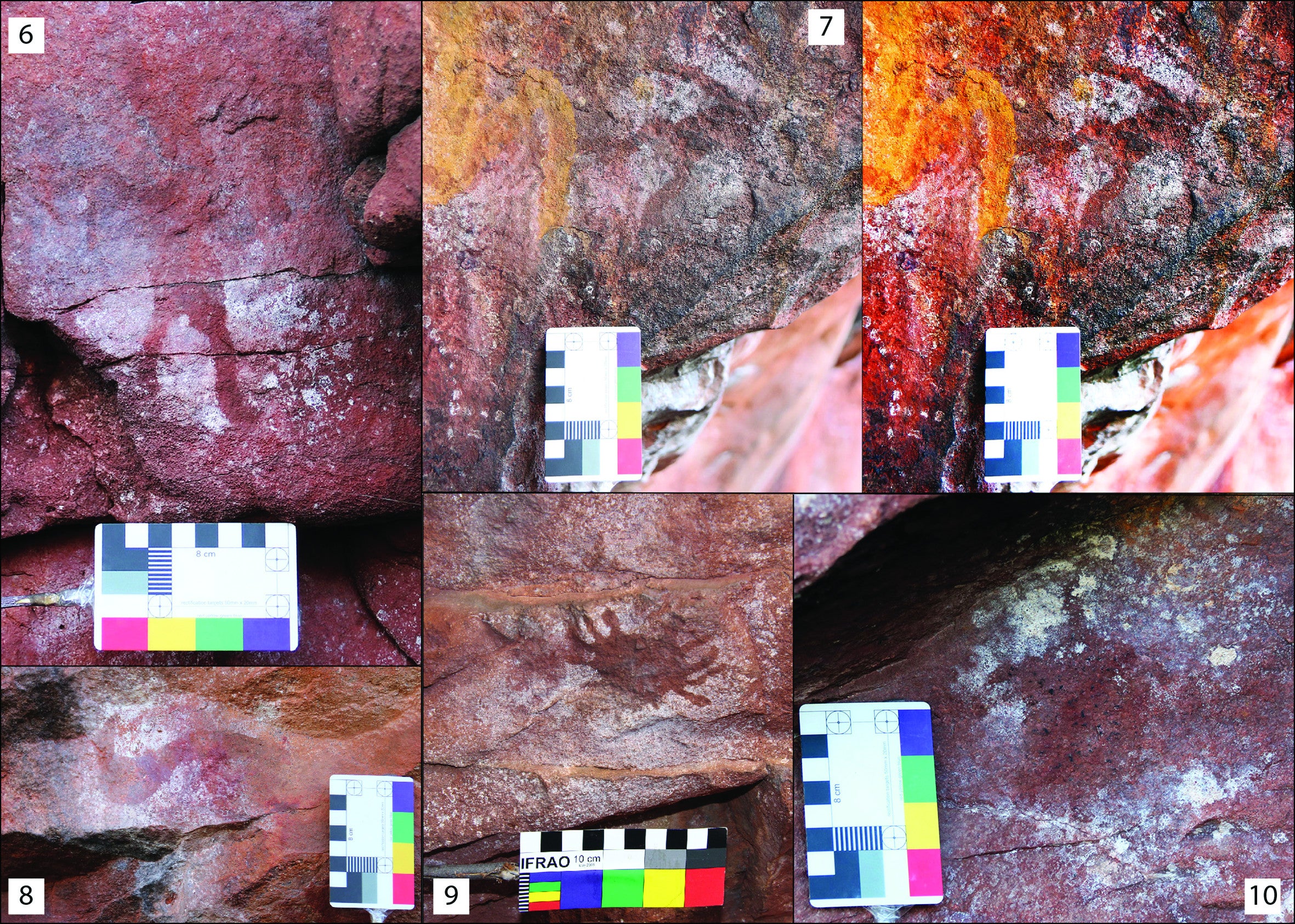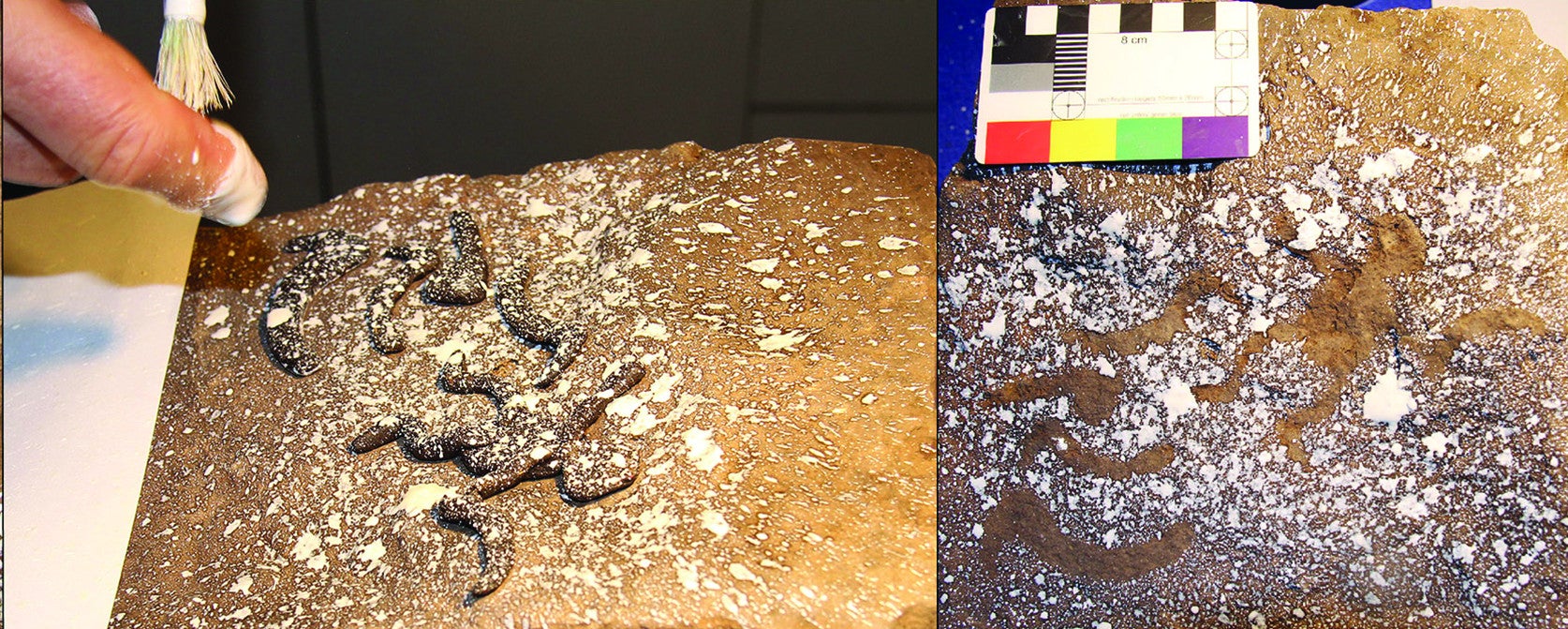
Miniature Rock Art Found in Australia May Have Been Stencilled by Children
by George DvorskyArchaeologists working at a rockshelter in northern Australia have discovered a trove of unusual miniaturised rock art made using stencils. This rare form of rock art may have served an ominous supernatural purpose – or it might be whimsical doodles made by children.
Nearly 60 small-scale stencils have been documented at the Yilbilinji 1 rockshelter at Limmen National Park in northern Australia. Rock art in which figures and objects are portrayed in miniature is exceptionally rare, with the only other two examples found at Nielson’s Creek in New South Wales and Kisar Island in Indonesia. The small-scale stencils at Yilbilinji 1 now comprise the largest collection of this kind of rock art in the world. Details of the research, led by archaeologist Liam Brady from Flinders University in Australia, will be published in the June edition of Antiquity.
The Yilbilinji 1 rockshelter is traditionally owned by the Maara Aboriginal people and was first documented by archaeologists in 1974. Three years ago, Brady and his colleagues performed an exhaustive survey of rock art at the site, resulting in the documentation of over 350 distinct artworks. The expedition was a collaborative effort, in which the archaeologists were assisted by park rangers and Marra Traditional Owners.

Samples of art found at Yilbilinji 1. (Image: L. M. Brady et al., 2020/Antiquity)
Of the 59 stencils found at Yilbilinji 1, 17 were classified as miniature or small-scale, in which the subject matter is “considerably smaller than life size or whose proportions are unrealistic when compared to full- or life-sized examples,” according to the paper.
The stencilled depictions included human figures, animals and animal parts (e.g. crabs, turtles, and kangaroo paws), boomerangs, shields, geometric shapes, and wavy lines. No dates were given for the stencils, but rock art in the region dates back for thousands of years.
Normally, stencilled rock art, like those found in the Sahara, are made by overlaying life-sized objects, such as human hands, animal parts, tools, and plants, against a cave wall and applying a paint-like medium. The tiny stencils at Yilbilinji 1 couldn’t possibly have been made in this way, requiring the researchers to investigate further and perform some experimental archaeology.
The well-rounded, curved shape of the stencils provided a clue, suggesting the templates were made from a malleable substance. What’s more, the material was probably sticky, allowing the artist to tack the template onto the rock wall. A final clue came from anthropological work done in the 1980s, documenting a cultural practice in which indigenous Australian children used beeswax to produce miniature figurines, such as cattle, horses, and cowboys. The researchers combined all of these factors and observations to “suggest that beeswax, as a portable, malleable and adhesive material, was the most likely source material used to sculpt the stencil templates at Yilbilinji 1,” as the authors wrote in the study.

Researchers replicating the technique used to create the stencilled drawings. (Image: L. M. Brady et al., 2020/Antiquity)
Not content to stop there, the archaeologists conducted an experiment to test the beeswax hypothesis. They reconstructed all 17 motifs documented at the rockshelter by heating and shaping balls of beeswax. They used a mixture of clay and water was used to simulate the paint-like medium and a paintbrush to flick the paint while the template was affixed to a slab of rock.
It worked.
Fascinatingly, the flicker patterns seen in the experiment closely matched those seen in the rockshelter, which points to the possible use of an ancient paintbrush-like tool. If confirmed, “this would add another dimension to their production process,” wrote the authors. Unfortunately, the scientists did not analyse the residue of the ancient stencils, but they’re planning to do exactly that in the future. A chemical analysis would shed light on the medium used to produce the stencils and possibly assist with dating the artworks.
Brady and his colleagues don’t fully understand the reason behind the small-scale stencils, but they offered some possible explanations, such as an association with Aboriginal law, ancestral beings, or even sorcery. As the authors explained in the paper, a neighbouring Yanyuwa group is known to have used rock art as way to cast nefarious spells:
[Yanyuwa] men were referencing narnubulabula (also known as wirlkin) – a powerful and highly feared form of site-specific sorcery that involves the production of rock art (paintings, stencils, prints and beeswax in its traditional form – affixed to, and left on, a rock surface) at Kurrmurnnyini (Gudanji Country) and Nangkuya (Marra Country). Men with the correct kinbased relationships to these sites were able to create motifs to attack the life force of a selected victim. The singing of potent sorcery songs over these motifs would empower the motifs to ensorcel [i.e. to enchant] and kill people.
Another idea, one far more benign than sorcery, is that these stencils were created by children. It’s a forehead-slapping revelation, no doubt, but a distinct possibility, according to the researchers. Indeed, stencils of turtles and kangaroo paws certainly seem like something kids might want to inscribe onto a rock wall. This may have been a culturally sanctioned activity, in which the children were given balls of beeswax for this explicit purpose.
“While there is no definitive way for us to determine that the stencil assemblage at Yilbilinji was produced by children, the implication of children being related to the production of these motifs raises questions of both the possible [educational] nature of the assemblage (such as the possibility of children creating models of weapons), and the practice of inscribing landscapes more generally,” wrote the authors, adding that archaeologists should “consider in more detail the role of children in the archaeological record.”
Children are often overlooked in archaeology, so it’s refreshing to see them included as the possible creators of these remarkable artworks, even if the evidence is a bit lacking.
This actually reminds me of a paper from last year, in which archaeologists from the National Museum of Natural History in Paris described a trove of fossilised Neanderthal footprints. The prints, left in mud some 80,000 years ago in what is now Normandy, France, included a surprisingly disproportionate number of tracks made by children. The authors took great pains to explain why so many children were assembled into one place without parental supervision, such as the adults going off-site or the high rate of adult mortality among Neanderthals. To my surprise, the authors did not consider the possibility that the Neanderthal kids were just being kids – they were simply attracted to, and were playing within, the muddy soil. When I inquired about this possibility, the authors ignored my question.
Now, I’m not saying I’m absolutely correct about this – I’m just vibing with the authors of the new study and their appeal to archaeologists to consider the role of children in their research. Otherwise, our appreciation of the past will remain woefully incomplete – and possibly even wrong.
Featured image: L. M. Brady et al., 2020/Antiquity